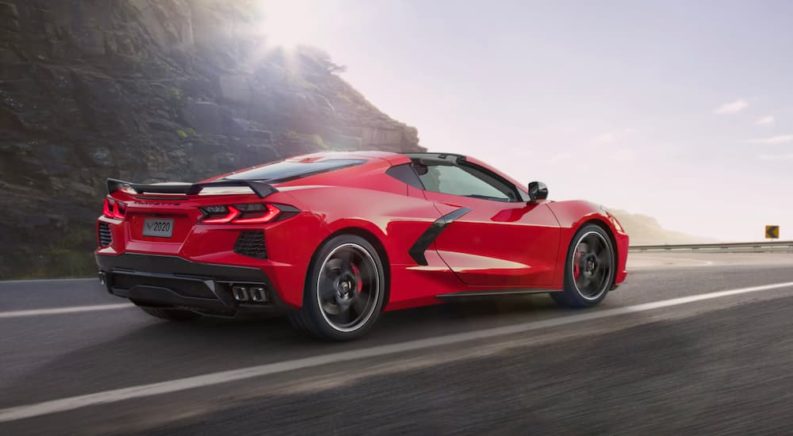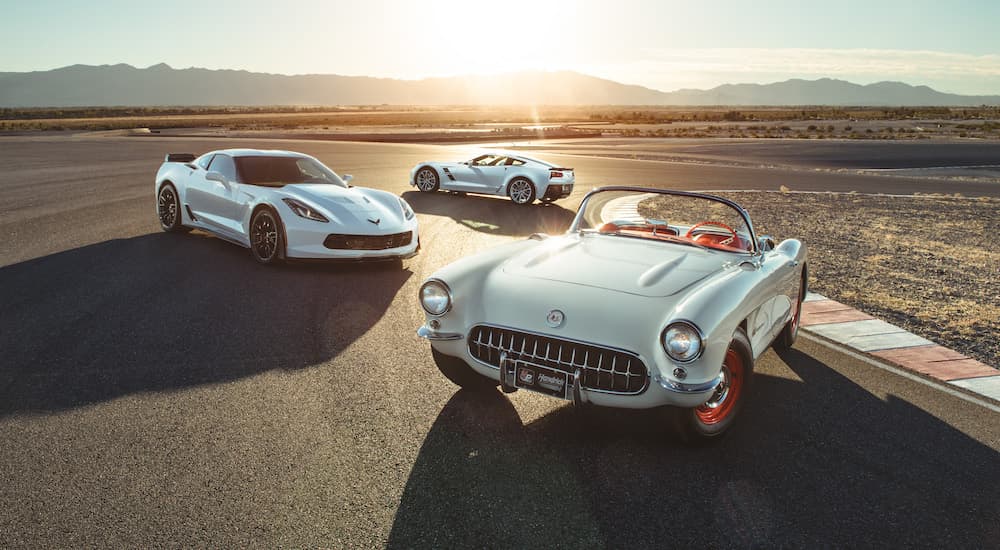Nationwide, every Chevrolet dealer heard only crickets in 1953 when the Corvette debuted, failing to impress drivers as Chevrolet envisioned. The automaker had a lot riding on the Corvette, hoping it would pull the company out of a sales slump. However, the first-generation model was a massive flop, with Chevy selling only 183 models. So, what was the issue?
The Corvette wasn’t fast enough to be a muscle car, leaving its luxury to carry the weight of its success. Even then, its opulence wasn’t extraordinary enough to appeal to those with deep pockets, and that left the Corvette without a proper home in America’s automotive landscape. Fortunately, Chevy learned a valuable lesson and redesigned the model in 1956, giving it a distinct aesthetic and a more capable powertrain. But that was only the beginning, as the Corvette’s subsequent success paved the way for the Stingray.
Chevrolet debuted the Corvette Stingray in 1963. The fiberglass coupe distinguished itself in the fiercely competitive segment with its potent V8 engine, vented hood, and independent rear suspension. Its sole focus on performance and its success at delivering sealed its fate in the industry, but that wasn’t the end of Chevy’s ingenuity. Today, the Corvette’s transformation into a mid-engine marvel shows how Chevrolet is constantly looking for ways to improve its legendary muscle car and give more drivers access to a supercar with an affordable price tag. It’s a combination worthy of every ooh and ahh you can muster.
Laying the Foundation: The Stingray’s Center Tunnel
Chevrolet has a rich history of building high-performance engines, so transforming the Corvette Stingray into a mid-engine layout in 2020 wasn’t a massive leap for the automotive pioneer. After years of promising enhanced power and capability, Chevy delivered, relying on its ingenuity to make the redesign successful. But why use a mid-engine layout to amp up the Corvette Stingray’s already impressive power and performance? Because more power is always better.
Before repositioning the engine, Chevrolet relied on another area of its expertise; using aluminum space frames. Having mastered this with the Z06 in 2006, Chevrolet set out to finetune the design by building a lighter yet stiffer structure. The result shifted the design focus to the center tunnel, the backbone of the Stingray that would lay the foundation for what would soon be known as the “Bedford Six.”
The Bedford Six
The key to redesigning the Stingray’s structure was to reduce its weight without compromising its rigidity, performance, or handling. Chevrolet accomplished this by using a mixed-materials strategy, or six die-cast aluminum components, to reduce the number of spot welds in the frame to increase its rigidity and stiffness. Those six components are known as the “Bedford Six,” named after the manufacturing plant where they are produced in Bedford, Indiana.
The Bedford Six components serve as the skeleton for the Stingray’s tunnel-centric design, relying on a center tunnel to serve as the car’s structural backbone. The approach is advantageous for many reasons. First, its streamlined structure improves stability by positioning the Stingray closer to the ground. As a result, it has a lower center of gravity that gives you a greater sense of control over the car, while the improved torsional rigidity gives you a physical-like connection to how the Stingray feels on the road.
Second, the tunnel-centric design improves the driver experience in several critical ways. For example, it optimizes the size of the cabin, nearly doubling the recline angle of the seats. Likewise, it makes ingress and egress easier since it doesn’t rely on additional rocker panels for structural support, a solution to a common issue with most supercar designs. And finally, its rigid and high-strength design eliminates any concern of structural integrity, allowing drivers to remove the Stingray’s iconic roof panel and confidently enjoy every ride.
Why the Mid-Engine Layout Works
The Stingray’s tunnel-centric structure accommodates its mid-engine layout, which many refer to as “the jewel in the center.” Chevrolet’s purpose for moving the engine was to improve traction, but the rewards are far greater than having more grip on the road. The 2020 Corvette Stingray made history as the fastest and most powerful entry-level Corvette in history, courtesy of its naturally aspirated V8 engine churning out 495 hp and 470 lb-ft of torque. The 2023 Stingray continues that tradition, which begs the question, “What else can drivers expect from the mid-engine layout?”
Moving the engine behind the driver improves traction by shifting the center of gravity and more evenly distributing the Corvette’s weight, but it also impacts the cockpit and the entire driving experience. Relocating the V8 engine frees up space at the front of the Stingray, allowing Chevrolet to move the cockpit forward 16.5 inches. This shift enhances visibility and completely alters the user experience, with the cockpit enveloping the driver like a pilot in a fighter jet.
The Stingray’s repositioned cockpit also moves the center of gravity to the driver’s right hip. The result is exceptional because it gives the driver the feeling that the Stingray is turning around them. This incredible feeling also correlates to the Stingray’s eight-speed dual-clutch transmission, a first for Chevrolet. The uniquely designed transmission delivers smooth, immediate gear shifts and a nearly instantaneous transfer of power, characteristics expected of a supercar like the Stingray. With the mid-engine layout, those gear shifts are even more impressive.
Lastly, the mid-engine layout doesn’t solely enhance the Stingray’s performance, but it also adds to its aesthetic. While the Stingray is designed with a sleek supercar silhouette, Chevrolet enhances its design by making the mid-engine layout a focal point rather than a distraction. As the jewel in the center, the Stingray’s engine is an integral part of its design and is visible through the Stingray’s rear hatch window. Because of this, the engine isn’t solely a workhorse or a machine but a piece of art. Every detail is exquisite, from the wires and fasteners to the bolts, tubes, hoses, and red valve covers that showcase the mid-engine marvel for what it undoubtedly is: a modern and stunning marvel.
Some Things Change, and Some Remain the Same
It’s hard to believe the Corvette was a flop for Chevrolet in the 1950s, a time when the automaker needed a saving grace from its dire sales slump. Yet, while the failure would’ve been easy to admit and walk away from, Chevrolet dug in its heels and returned to the drawing board. Its perseverance paid off, with the Corvette finally finding its footing in the segment just a few years later before making history with the second-generation Stingray in the 1960s.
Perseverance is a theme for Chevrolet, but so is ingenuity, and that’s an incredible pairing in today’s fiercely competitive landscape. Long after sealing its fate as Chevrolet’s legendary powerhouse, the Corvette Stingray reinvented itself as a mid-engine marvel. Instead of resting on its haunches, Chevrolet set its sights on giving drivers more power and capability from the icon.
Relying on its vast experience in engine and structural ingenuity, Chevrolet breathed new life into the Corvette Stingray. And while the automaker has received a lot of criticism for doing away with the Corvette’s manual transmission, Chevrolet has more than made up for it. The Stingray’s tunnel-centric design and repositioned center of gravity enhances the Corvette’s performance and guarantees an engaging and dynamic driving experience. The result is extraordinary, making the Corvette Stingray a unicorn in the industry because it handles like an exotic sports car without the mile-high price tag. And to think the first Corvette barely caused heads to turn.






